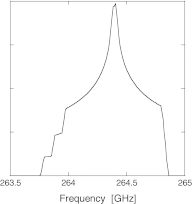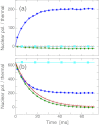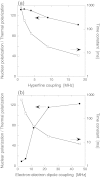Theory for cross effect dynamic nuclear polarization under magic-angle spinning in solid state nuclear magnetic resonance: the importance of level crossings
- PMID: 22938251
- PMCID: PMC3443114
- DOI: 10.1063/1.4747449
Theory for cross effect dynamic nuclear polarization under magic-angle spinning in solid state nuclear magnetic resonance: the importance of level crossings
Abstract
We present theoretical calculations of dynamic nuclear polarization (DNP) due to the cross effect in nuclear magnetic resonance under magic-angle spinning (MAS). Using a three-spin model (two electrons and one nucleus), cross effect DNP with MAS for electron spins with a large g-anisotropy can be seen as a series of spin transitions at avoided crossings of the energy levels, with varying degrees of adiabaticity. If the electron spin-lattice relaxation time T(1e) is large relative to the MAS rotation period, the cross effect can happen as two separate events: (i) partial saturation of one electron spin by the applied microwaves as one electron spin resonance (ESR) frequency crosses the microwave frequency and (ii) flip of all three spins, when the difference of the two ESR frequencies crosses the nuclear frequency, which transfers polarization to the nuclear spin if the two electron spins have different polarizations. In addition, adiabatic level crossings at which the two ESR frequencies become equal serve to maintain non-uniform saturation across the ESR line. We present analytical results based on the Landau-Zener theory of adiabatic transitions, as well as numerical quantum mechanical calculations for the evolution of the time-dependent three-spin system. These calculations provide insight into the dependence of cross effect DNP on various experimental parameters, including MAS frequency, microwave field strength, spin relaxation rates, hyperfine and electron-electron dipole coupling strengths, and the nature of the biradical dopants.
Figures










Similar articles
-
Theoretical aspects of Magic Angle Spinning - Dynamic Nuclear Polarization.J Magn Reson. 2015 Sep;258:102-20. doi: 10.1016/j.jmr.2015.07.001. Epub 2015 Jul 13. J Magn Reson. 2015. PMID: 26232770
-
Role of electron spin dynamics and coupling network in designing dynamic nuclear polarization.Prog Nucl Magn Reson Spectrosc. 2021 Oct-Dec;126-127:1-16. doi: 10.1016/j.pnmrs.2021.05.003. Epub 2021 Jun 1. Prog Nucl Magn Reson Spectrosc. 2021. PMID: 34852921 Review.
-
Verdazyl-ribose: A new radical for solid-state dynamic nuclear polarization at high magnetic field.J Magn Reson. 2018 Apr;289:122-131. doi: 10.1016/j.jmr.2018.02.016. Epub 2018 Mar 1. J Magn Reson. 2018. PMID: 29501956 Free PMC article.
-
Frequency swept microwaves for hyperfine decoupling and time domain dynamic nuclear polarization.Solid State Nucl Magn Reson. 2015 Nov;72:79-89. doi: 10.1016/j.ssnmr.2015.10.001. Epub 2015 Oct 9. Solid State Nucl Magn Reson. 2015. PMID: 26482131 Free PMC article.
-
Broadband adiabatic inversion cross-polarization phenomena in the NMR of rotating solids.Solid State Nucl Magn Reson. 2018 Oct;94:31-53. doi: 10.1016/j.ssnmr.2018.08.003. Epub 2018 Aug 10. Solid State Nucl Magn Reson. 2018. PMID: 30125798 Review.
Cited by
-
19F Dynamic Nuclear Polarization at Fast Magic Angle Spinning for NMR of HIV-1 Capsid Protein Assemblies.J Am Chem Soc. 2019 Apr 10;141(14):5681-5691. doi: 10.1021/jacs.8b09216. Epub 2019 Apr 1. J Am Chem Soc. 2019. PMID: 30871317 Free PMC article.
-
Numerical recipes for faster MAS-DNP simulations.J Magn Reson. 2021 Dec;333:107106. doi: 10.1016/j.jmr.2021.107106. Epub 2021 Nov 9. J Magn Reson. 2021. PMID: 34837803 Free PMC article.
-
Paramagnet induced signal quenching in MAS-DNP experiments in frozen homogeneous solutions.J Magn Reson. 2014 Mar;240:113-23. doi: 10.1016/j.jmr.2013.11.013. Epub 2013 Dec 7. J Magn Reson. 2014. PMID: 24394190 Free PMC article.
-
Dynamic nuclear polarization at 40 kHz magic angle spinning.Phys Chem Chem Phys. 2016 Apr 21;18(15):10616-22. doi: 10.1039/c6cp00839a. Epub 2016 Apr 1. Phys Chem Chem Phys. 2016. PMID: 27035630 Free PMC article.
-
Dynamic Nuclear Polarization of Biomembrane Assemblies.Biomolecules. 2020 Aug 27;10(9):1246. doi: 10.3390/biom10091246. Biomolecules. 2020. PMID: 32867275 Free PMC article.
References
-
- Overhauser A. W., Phys. Rev. 92(2), 411 (1953).10.1103/PhysRev.92.411 - DOI
-
- Carver T. R. and Slichter C. P., Phys. Rev. 92(1), 212 (1953).10.1103/PhysRev.92.212.2 - DOI
-
- Idehara T., Kosuga K., Agusu L., Ikeda R., Ogawa I., Saito T., Matsuki Y., Ueda K., and Fujiwara T., Int. J. Infrared Millim. Waves 31(7), 775 (2010).10.1007/s10762-010-9643-y - DOI
Publication types
MeSH terms
Grants and funding
LinkOut - more resources
Full Text Sources
Other Literature Sources
Miscellaneous

